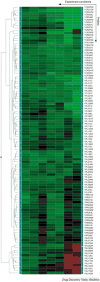Information Visualization Techniques in Bioinformatics during the Postgenomic Era
- PMID: 20976032
- PMCID: PMC2957900
- DOI: 10.1016/S1741-8364(04)02423-0
Information Visualization Techniques in Bioinformatics during the Postgenomic Era
Abstract
Information visualization techniques, which take advantage of the bandwidth of human vision, are powerful tools for organizing and analyzing a large amount of data. In the postgenomic era, information visualization tools are indispensable for biomedical research. This paper aims to present an overview of current applications of information visualization techniques in bioinformatics for visualizing different types of biological data, such as from genomics, proteomics, expression profiling and structural studies. Finally, we discuss the challenges of information visualization in bioinformatics related to dealing with more complex biological information in the emerging fields of systems biology and systems medicine.
Figures


References
-
- Shneiderman B. The eyes have it: a task by data type taxonomy for information visualizations. Proceedings 1996 IEEE Symposium on Visual Languages; pp. 336–43.
-
- Keim DA, Ankerst M. Visual Data Mining and Exploration of Large Databases. Tutorial at PKDD'2001; 2001; Freiburg, Germany.
-
- Chi EH. A taxonomy of visualization techniques using the data state reference model. Proceedings of IEEE Visualization; 2000. pp. 69–75.
-
- Pfitzner D, et al. A Unified Taxonomic Framework for Information Visualization. Conferences in Research and Practice in Information Technology; Adelaide, Australia. 2003. pp. 57–66.
Grants and funding
LinkOut - more resources
Full Text Sources
